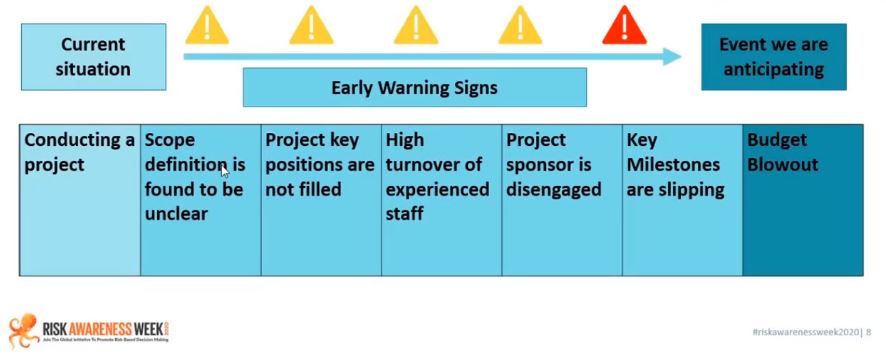With information and other demands for our attention bombarding us each day, it can be hard to think about the long-term. As a growing number of examples show, ignoring long-term risks to strategic objectives can be devastating, especially considering the world of Volatility, Uncertainty, Complexity, and Ambiguity (VUCA) we find ourselves in.
While discussing the VUCA concept in his book Decide to Succeed, Hans Læssøe instructs us:
In such a world, it is a matter of diligent preparation to ensure decisions and plans cater effectively to handling risks and uncertainties.
It can be hard to take the time to gaze into the future to anticipate what might occur, but it is vitally important to do so as best you can. While companies like General Motors have their own methods for understanding long-term or future risks, many organizations tend to forego this type of risk assessment because of time, logistical, and other constraints.
Signpost analysis is one tool organizations of any size and budget can use to understand long-term risks that slowly materialize.
Originating from the intelligence community, signpost analysis is a tool used for predicting uprisings and other significant events. Former Canadian combat engineer and current Director of Enterprise Risk at VIA Rail Canada, Benoit Ladouceur, discusses signpost analysis and a variety of other quick risk assessment methods in a session from the annual Risk Awareness Week.
As Benoit explains in his intro, risk managers can learn a lot from military and intelligence personnel about managing complex, uncertain situations.
In the business context, signpost analysis can be helpful for understanding long-term strategic risks that, when taken in the aggregate, can have huge impacts on the organization. Benoit uses a familiar analogy to explain the concept:
…something that is basically the frog in the boiling pot where you don’t see the signs until it is too late and then you didn’t act and you get took [sic] by surprise.
Examples of where signpost analysis can be applied include understanding:
- Climate change impacts
- Political unrest
- Economic recession/depression
- Competing commercial products or services (e.g., taxi vs. ride-share)
- Internal projects and initiatives
In the case of VIA Rail Canada, Benoit explains how they currently use signpost analysis to better understand the risk of autonomous vehicles, which if adopted on a mass scale, would be a clear and present danger for a passenger rail line.
Below is a screenshot from the webinar of a sample signpost analysis for a large project. As you can see, you have the starting point of the project on the left and the possibility of the project’s failure or “budget blowout” on the right. If one of these events were triggered in isolation, it wouldn’t be a huge deal. However, if the triggers occur as a sequence or chain of events, the end result could be the project coming in way over budget or not being completed.

Each of these early warning signs represent a “milestone” or “sign post marker.”
There are no particular rules or set number of milestones – over time, you may add some or take others away. Milestones can either be completely qualitative or have some sort of measurable target (i.e., quantitative).
Each milestone serves as an early warning sign that a risk is starting to materialize. Instead of reacting and scrambling like the proverbial frog, this early warning system helps you proactively determine the right risk response in an orderly way. It also forces you to look at long-term trends that develop slowly and thus are easy to forget about.
Besides understanding when risks are materializing, signpost analysis is a helpful tool for combating confirmation bias and encouraging deep thinking.
The benefits of signpost analysis extend beyond understanding long-term risks.
As I discuss in this recent piece, confirmation bias, which basically involves picking and choosing information that supports your own opinion, is a common trap that prevents good decision-making. As Benoit explains in his session:
…we all have opinions. If we don’t keep [sic] open-minded, we will only pick information that suits us.
Taking the time to identify and research milestones can help protect against this dreaded problem since you are (…or at least you should be) looking at a variety of different sources, even ones you may personally disagree with.
Identifying and researching milestones also spurs deep thinking, which is something we tend to forego in today’s fast-paced world. However, taking the time to reflect instead of just going with your gut feeling will pay off tremendously when you prepare for long-term threats.
Gazing into the future to understand threats and opportunities can be more of an art than a science. However, with tools like signpost analysis, scenario planning and others, risk managers can transform the ERM function into a valuable tool for ensuring the company’s long-term success, not just avoid failure or satisfy regulators.
Signpost analysis was one of several tools Benoit discusses in his session. I highly recommend checking out the entire presentation from RAW 2020!
What type of tools do you use to understand long-term risks?
Have you and your organization been caught off guard by seemingly disparate events that culminate in a big way?
I’m always interested in learning more about methods for better understanding threats and opportunities. To share your thoughts and experiences, feel free to join the conversation on LinkedIn.
And if you are struggling with how to best understand long-term risks to your organization, please don’t hesitate to contact me to discuss your specific situation today!
Featured image courtesy of Viajero via Pexels.com








